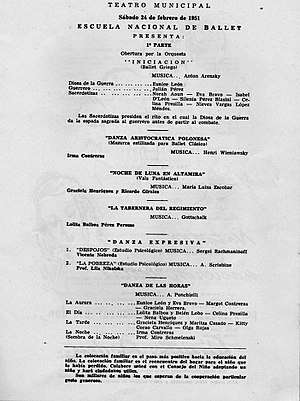Vicente Nebrada
Vicente Nebrada (born Vicente Balbino Nebreda Arias, 31 March 1930 - 26 May 2002) was a Venezuelan dancer and choreographer. Born in Caracas, Nebrada began his career as a dancer with the National Ballet of Venezuela, Alicia Alonso's National Ballet of Cuba, with Roland Petit in Paris, and with the Joffrey Ballet (1959).[1][2] Nebrada was a founding member of the Harkness Ballet,[1] where he created his first ballet Percussion for Six Men, in 1969.[2]

In 1975 Nebrada helped found the International Ballet of Caracas and became their artistic director and resident choreographer in 1977.[1][2] In 1984 he became the artistic director of the National Ballet of Caracas where he remained until his death due to leukemia in 2002.[1] His dances have been performed by Ballet Hispanico, American Ballet Theatre, Joffrey Ballet of Chicago, National Ballet of Canada, Berlin Opera Ballet, English National Ballet, Australian Ballet and the Universal Ballet of Korea.[2]
A distinctive style
His style is undeniably Neoclassical. His duets or pas de deux are known for their plasticity, expressiveness and intricate lifts. His partnering style shows a great deal of upper-body freedom while the ballerina moves on and off-balance. His spatial designs are symmetrical, harmonious and often organic, with dancers moving across the stage, while lending a visceral sense of ownership to his dances.
Many of his narrative ballets are filled with colors and dramatic effervescence. This approach is inherent to Latin American idiosyncrasy, and his existence is perhaps a residue from the classic ballets of the romantic era. Some of his best known narrative ballets or classical adaptations are The Nutcracker, Romeo and Juliet, FireBird, Don Quijote, Copelia, Cinderella, Inés de Castro, Van Gogh, and George Sand.[3]
He also imprinted his signature style to many abstract or non-narrative ballets. Some of them present some scenes based on stories or imagery, but they are still considered non-narrative as they do not follow a plot or a script. Examples include Our Waltzes, Lento a Tempo e Apassionato, La luna y Los híjos que tenía, Una Danza para ti, A Haendel's Celebration, Pentimento, Double Colchea and Fever, among others.
Allan Ulricht, writer of the Dance examiner for the San Francisco Chronicle, said: "…'Fever' is clearly an export ballet…" "…The choreography is structured like a classical diversion and Nebrada affirms the women's communal purpose with repeated circular forays. Some of the women struggle, others yield and one is raised aloft like the spirit of feminism triumphant. Thanks to the eight fearless dancers, the effect was intensely visceral. As La Lupe kept singing, 'Adios, adios, adios', I wanted to shout, 'Bienvenido, bienvenido, bienvenido…' (1995)[4]
Legacy
Nebrada's extensive body of work brought a sense of distinctiveness and relevance to Venezuela's cultural heritage. His choreographies continue to be performed around the world as they emerged during a particularly prosper era of Neoclassical ballet in the 20th century. He sought after dancers with both expressivity and technical abilities, and most of his male dancers also needed to be skilled partners. His choreographic style gave an identity to the National Ballet of Caracas, which became the resident ballet company of the Teresa Carreño Cultural complex in 1984. Despite frequent interruptions due to government cuts, the company's funding is subsidized mostly by the Venezuelan government. As with many other companies in the world, the National Ballet of Caracas continue to struggle to maintain its season, pay its dancers and remain viable.
Awards
Nebrada has been the recipient of numerous awards. Among them:
- 1976: Fokine Award, for the choreography Shadows awarded by the Dance University in Paris
- 1984: CONAC Award of Classic Dance, awarded by the National Cultural Council. Venezuela.
- 1986: Diego de Lozada award in its first class, awarded by the Venezuelan government. Venezuela
- 1991: National Artist Award: For his choreography “Swan Lake", awarded by Fundación Casa del Artista. Venezuela. *1991: National Artist Award: as choreographer of the year, awarded by Fundación Casa del Artista. Venezuela.
- 1992: National Dance Award, awarded for the first time in Venezuela.
- 1992: National Artist Award: as choreographer of the year, awarded by Fundación Casa del Artista. Venezuela
- 1993: Andres Bello Order in its First Class. Venezuela
- 1995: The Official Order of Simon Bolivar, celebrating 50 years of Artistic Achievements. Venezuela
- 1995: Municipality of Dance, awarded by local el libertador’s Council. Caracas, Venezuela.
- 1996: National Artist Award: as choreographer of the year, awarded by Fundación Casa del Artista. Venezuela.
- 2001: Monseñor Pellín Award in its XII edition: for The Nutcracker as best choreography for children. Venezuela<ref>Lobo, Belen. Nebreda-Nebrada. Printed by Editorial Arte in Caracas-Vzla., 1996
References
- "Vicente Nebrada". Luna Negra Dance Theater. Retrieved 2009-01-04.
- Dunning, Jennifer (2002-06-09). "Vicente Nebrada, 72, Leader Of Caracas National Ballet". The New York Times. Retrieved 2009-01-04.
- Belen, Lobo. Nebreda-Nebrada. Consejo Nacional De la Cultura. Fundacion Chacao. Editorial Arte. Caracas 06.1996
- [3] Allan, Ulrich. Examiner-Dance Critic, International Dance Troupes a Joy to See. San Francisco Examiner. 11 May. 1995. Web. www.sfgate.com